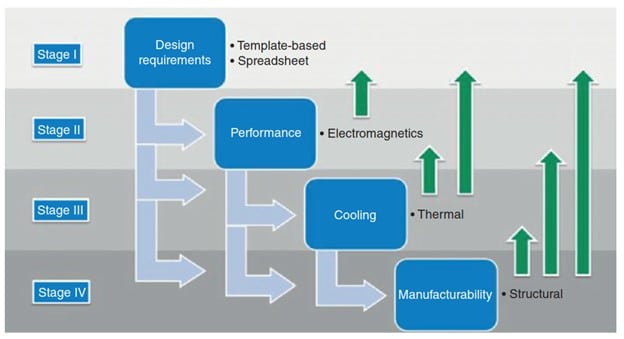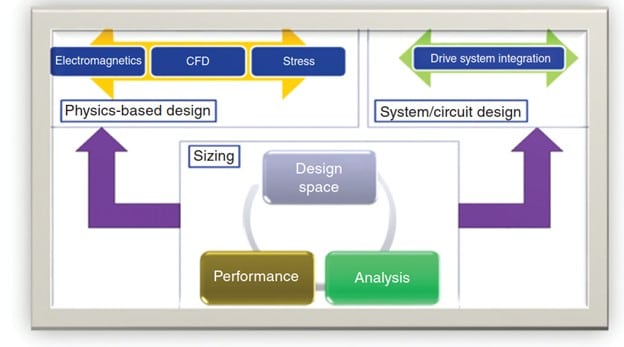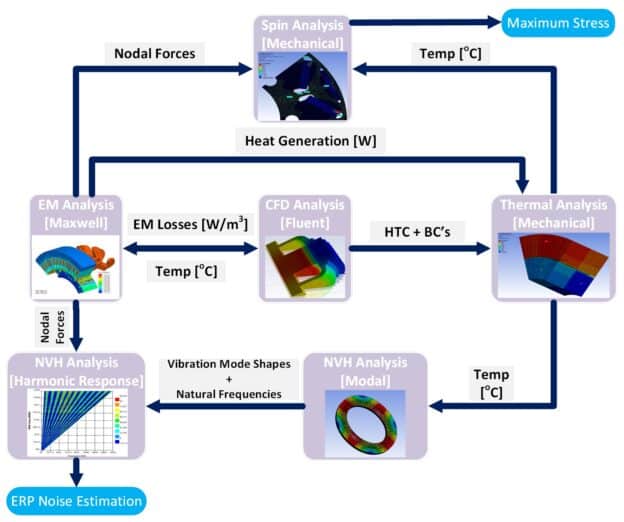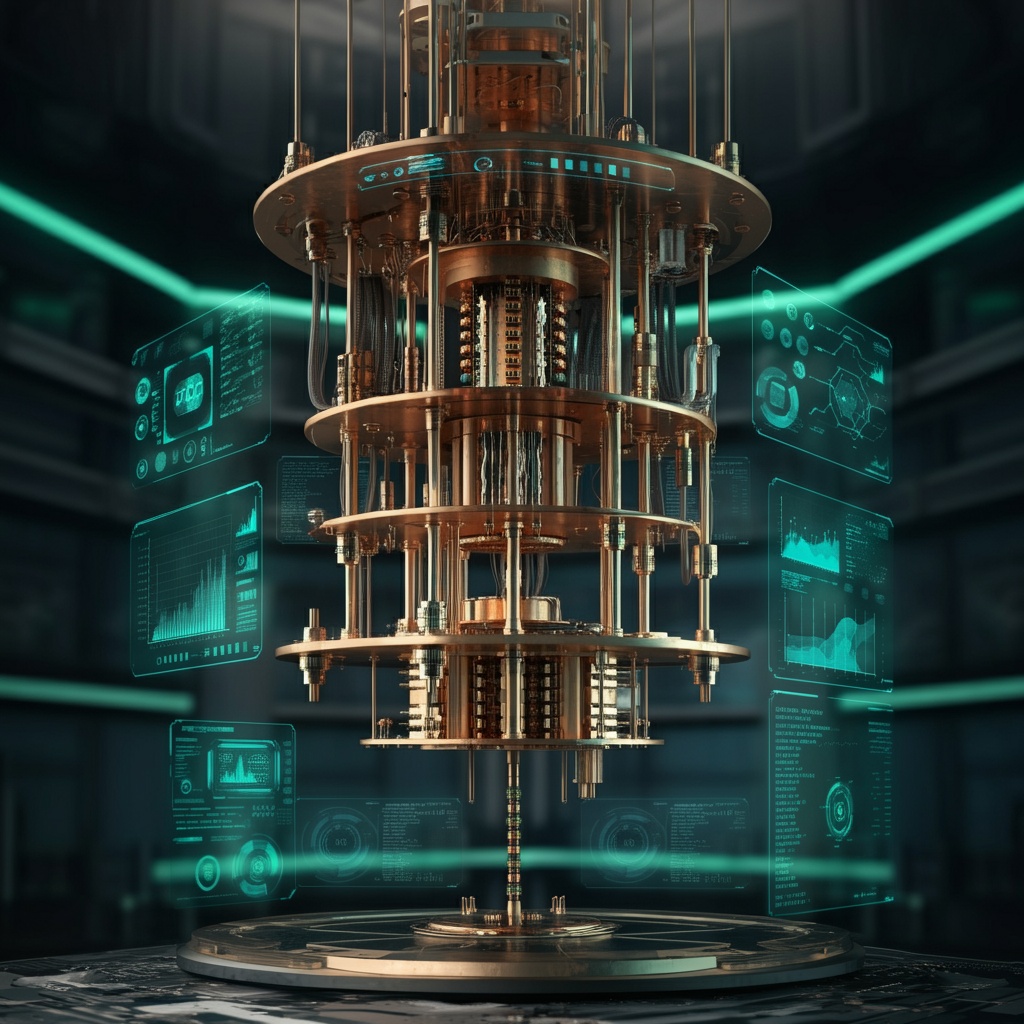Designing electric machines presents challenges, particularly with the complexities of multi-physics simulations. Key issues include accurate modeling, computational efficiency, and result validation. Advanced tools and improved methods are crucial for optimizing performance, reducing development time, and enhancing reliability in multi-physics applications.
Why Should We Use Multi-Physics Simulation to Start Off With?
Starting off with multi-physics simulation is crucial because electric machines are inherently complex, spanning various domains like electromagnetism, thermal dynamics, and mechanics. This approach offers a structured system for designing electric machines (as shown in Fig. 1), emphasizing detailed analysis to understand and refine intricate drive systems. Leveraging multi-physics simulation technologies empowers designers and engineers to create efficient and optimal designs for electric machines and drives, enabling thorough analysis and optimization.
When Should We Use Multi-Physics Simulation?
The electric motor design problem is inherently multidisciplinary, with various targets across multiple physics often conflicting. For instance, reducing rotor stress may compromise torque production, and mitigating noise levels through skewing can impact electromagnetic (EM) quantities, potentially reducing torque as well.
Attempting to optimize each physics aspect individually and then analyzing its effects on other aspects can be a time-consuming process. The most efficient approach is to address the system holistically. Therefore, when faced with multiple interdisciplinary design targets such as EM, thermal, noise, and vibration, multi-physics simulation becomes essential.
How is Identifying Design Requirements Important When Creating Initial Models?
The very first step in this method is to determine the kinds of design requirements that might be involved which could originate from internal design standards or external customer specifications.
These could be things like how fast the machine should go, how much power it needs, what the torque should be at various operating points, how efficient it needs to be overall or in specific operating conditions, and thermal characteristics. Engineers start out by sizing motors and making preliminary models where they will try different sets of them.
Classic methods help pick out possible sets quickly based on given requirements before more detailed analysis can take place.
Second Step: FEA for In-Depth Motor Study After Initial Design
Engineers then move on to thorough investigation using finite element analysis (FEA) once they have created an initial design. In this key stage, previously chosen topologies are electromagnetically qualified through complex numerical evaluations.
The primary design process is illustrated in Fig. 2. The initial design phase occurs during the sizing stage, where physical dimensions are determined based on magnetic and thermal feedback. This stage is specialized, enabling designers to swiftly create a geometric model of the machine, evaluate its performance, and make sizing decisions. Following the completion of the initial design, more detailed numerical methods (2D and 3D) are required to enhance the precision of these designs through simulation. These simulations are termed physics-based designs, encompassing numerical techniques such as electromagnetic simulation via finite elements, fluid dynamics solution via finite volumes, or structural simulation through finite element analyses.
Multi-Physics Analysis & Implementation on Ansys Workbench Platform
Ansys allows for thorough system integration by seamlessly transferring data from the design phase to analysis, then validating the design, and finally reaching the last verification stage as depicted in Fig. 3. This process mimics human-like testing, ensuring a comprehensive system simulation within a unified workflow.
As the various physics processes involved in motor design have such contradictory requirements, the necessity to have one platform, as shown in Fig. 3, where all processes can be analyzed at once is crucial. Therefore, the main objective of the proposed platform is to investigate possible candidates and filter them out based on their performance in EM, structural, thermal and NVH analyses.
By utilizing such methodology, the optimal design that meets all the targets in multiple physics is attained. The coupling workflow is established in a unified platform in Ansys Workbench.
After performing the EM analysis, the losses information is transferred to the CFD analysis in Ansys Fluent. Based on the cooling method adopted in this analysis, which is a water-jacket in the motor housing, the temperature of various surfaces is obtained.
As explained in the workflow, the two-way feedback connection, as illustrated in Fig. 4, is implemented between these two analyses which enables the temperature to be looped back into the EM analyses to obtain the effect on different quantities. Moreover, the temperature is mapped into both structural and NVH modules in addition to the nodal forces which makes the stress and calculations of the acoustic noise more accurate and realistic.
Conclusion: What to do Next
Multi-physics simulation has revolutionized the design of electric machines, integrating various physical domains, such as electromagnetism, thermal dynamics, and mechanics, into a cohesive and comprehensive analysis process. This holistic approach allows designers to address complex, often conflicting design targets efficiently and effectively, resulting in optimized performance and reliability. By leveraging advanced tools and methods, engineers can ensure accurate modeling, enhance computational efficiency, and validate results rigorously, ultimately producing highly efficient and reliable electric machines.
If you are looking to harness the power of multi-physics simulation for your electric machine designs, SimuTech Group’s team of experts is here to help. With extensive simulation consulting experience and access to Ansys’ most advanced multi-physics simulation tools, we can guide you through the entire process, from initial design requirements to detailed analysis and optimization. Contact us today for a consultation and discover how multi-physics simulation can transform your design process and elevate the performance of your electric machines.
About the Author

Ahmed Abdelrahman, Ph.D., P.Eng.
Senior Staff Engineer
With a specialization in electric motor design, CFD and thermal analysis, NVH analysis, and diverse motor design techniques, I bring a comprehensive skill set to the field of electrical engineering. My expertise lies in conceptualizing, modeling, and optimizing cutting-edge electric motor technologies. By employing advanced computational fluid dynamics (CFD) and thermal analysis tools, I ensure optimal motor performance by addressing heat dissipation and thermal management challenges. In addition, my proficiency in detailed NVH analysis enables me to mitigate noise, vibration, and harshness issues, delivering quieter and smoother motor operations. I am well-versed in various motor design techniques, including switched reluctance motors, permanent magnet motors, and induction motors, allowing me to tailor solutions to meet specific client requirements. Continuously staying updated on the latest industry trends and emerging technologies, I am committed to pushing the boundaries of electric motor design, enhancing efficiency, reliability, and sustainability.
Related Content
Electric Machine Design Consulting
Achieve the maximum possible torque in the smallest size and lowest costs.
Ansys Multiphysics Software
Explore all the real-world physical interactions a complex product may encounter.
Engineering & Simulation Webinars
View upcoming and on-demand webinars while learning about simulation software features, updates and best practices.
Industry Solutions
SimuTech Group provides industry-specific capabilities and expertise that deliver the flexibility and scalability you need for your specific projects.









